Why I Took My Son on a Baseball-themed Trip to Tokyo
- Oops!Something went wrong.Please try again later.
When my son, a lifelong sports fan, expressed an interest in visiting the baseball stadiums of Japan, I planned a once-in-a-lifetime trip to Tokyo. The result was a home run.
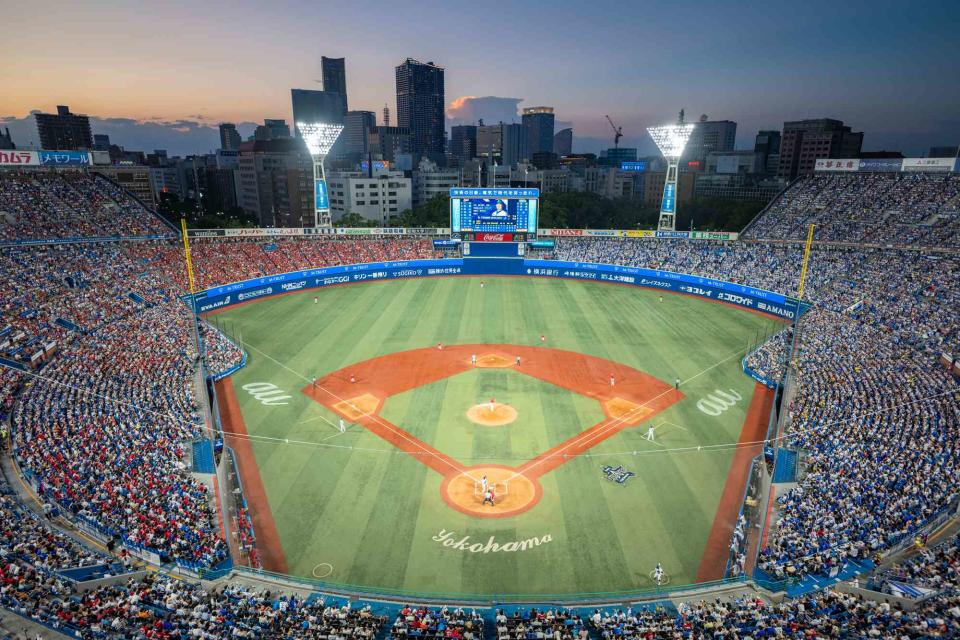
Irwin Wong
Yokohama Stadium.When it comes to sports, I’ve always considered myself a good date. On trips to Yankee Stadium with my high school boyfriend, I happily drank beer and ate Cracker Jack — when he was watching the game and we weren’t making out. In college, I toured the National Baseball Hall of Fame with a guy I was seeing. He’d agreed to drive me across New York State to Albany to visit a friend, and Cooperstown, his carrot, was simply on the way. I kept on being an amiable companion when I met my husband, attending his alma mater’s big games.
But then our son, Isaac, turned out to be “all ball,” and I became a legitimate groupie. For years, I cheered at the top of my lungs at his soccer, softball, and basketball matches. (This was also a form of primal screaming, and much cheaper than therapy.)
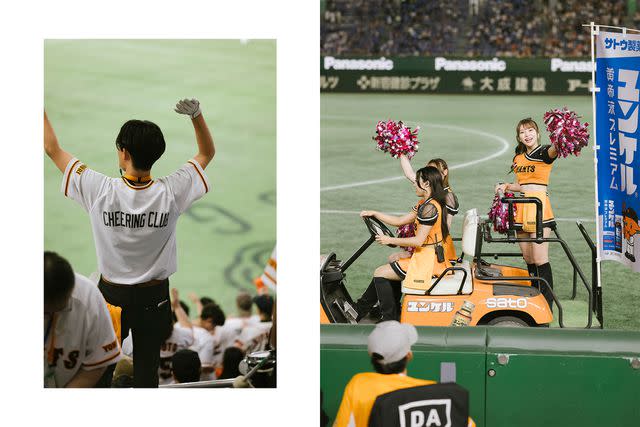
Irwin Wong
From left: A Yomiuri Giants fan leads cheers in the stands; cheerleaders for the Giants.Cut to last summer. Isaac was 24, and I was still a besotted mother. Summer vacation loomed before me — I’m a writer and an academic — and post-pandemic, I was eager for revenge travel. My son and I shared a dream of going to Japan. He was drawn to Japanese baseball, I was drawn to the culture, and we were both drawn to the food.
"Waz and Isaac went off to buy bento boxes, which at the stadium are named after ball players and filled with those players’ favorite foods. Of course, Isaac picked Okamoto’s, which contained chicken four ways: fried, Buffalo, smoked, and with some kind of white sauce."
That is how I found myself in the middle of a nine-hour baseball-palooza in the Isaac-heaven of the Tokyo Dome, Japan’s biggest indoor baseball arena. We were both jet-lagged and culture-shocked, having arrived the night before from New York City, but Isaac was already in a state of bliss. He knows everything about baseball, and religiously follows MLB, college, Korean, Dominican, and, yes, Japanese ball clubs.
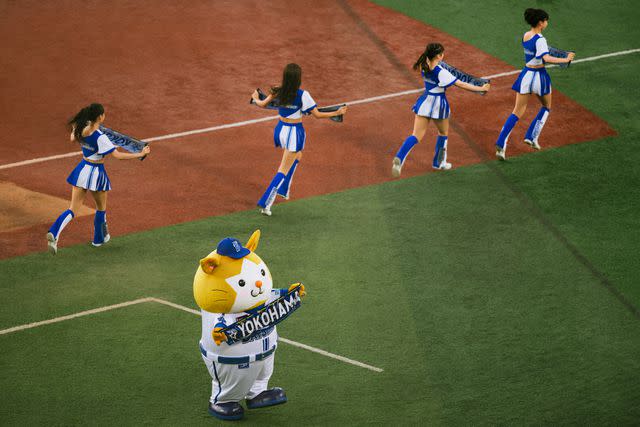
Irwin Wong
DB. Starman, the hamster mascot for the Yokohama DeNA BayStars, with a troupe of cheerleaders.We were also meeting, for the first time, Wazan Hoshino, a 22-year-old Japanese native now attending school in the States. Waz, as he likes to be called, was home for his summer holiday, and had volunteered to be our interpreter on an all-day, epic tour of the stadium.
This would lead up to the main event: the evening game between the Yomiuri Giants — the home team, and the most popular in the country, now fourth in the standings — and the Yokohama DeNA BayStars, who, remarkably for them, were in second place. (They’re kind of the Mets of Japan.) These are teams Isaac has been following from afar for years, watching their games on his computer in the early morning hours.
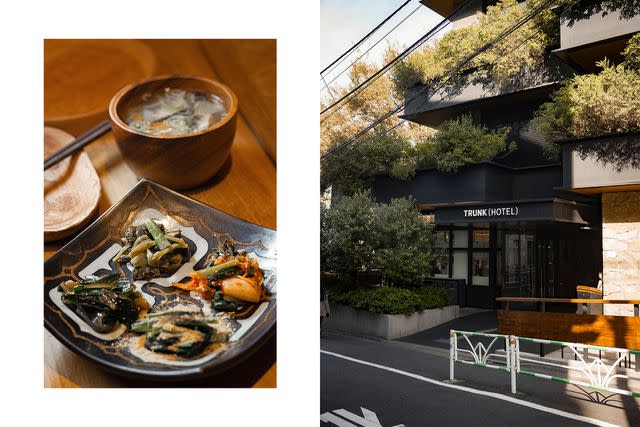
Irwin Wong
From left: Traditional dishes of the Indigenous Ainu people at Harukor; Trunk (Hotel), a property in Tokyo's Shibuya neighborhood.Our guide, Tatsuya Ohno, worked in the Yomiuri Shimbun newspaper’s baseball promotion department. On this sweltering day, Ohno, who is in his late twenties, somehow looked graceful and cool in his black suit — I don’t know how. The boys were in shorts. Ohno, with his staff pass, walked us throughout the Tokyo Dome, which is housed in Tokyo Dome City, an “entertainment zone.” (The compound contains a hotel, an amusement park where you can sing karaoke on a Ferris wheel, which was not on our to-do list, and the Japanese Baseball Hall of Fame & Museum, which definitely was.) The air-conditioned Dome, which is shaped like a giant egg, has a capacity of about 43,500 people.
As Ohno led us through the basement halls near the locker rooms, past the players’ cafeteria, and into the bullpen, the boys got more and more excited. Then a player walked past us and through the open doors onto the field. Isaac spun around. “Kazuma Okamoto!” he said.
“Who’s that?” I asked.
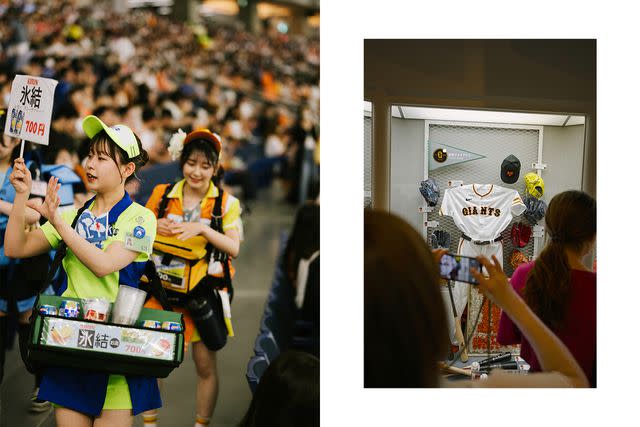
Irwin Wong
From left: Female beer vendors, or uriko, at the Tokyo Dome; baseball memorabilia at the Tokyo Dome.“He’s leading the Japanese League in home runs,” he said in the very patient and sweet voice he was now adopting and would use for the entirety of our nine-day trip. My son’s not talking down to me, I told myself. He’s just being sensitive to my lack of knowledge. The way I used to talk to him.
“Oh my God,” Waz said. “I feel like I’m in a dream!”
We went out onto the field. Practice was starting up. Ohno introduced us to some of the players, including a pair of Americans, Tyler Beede and Lewis Brinson. They were friendly and seemed happy living in Tokyo, although they mentioned that the Japanese tend to train longer and harder than U.S. players. I thought about this as I watched the Giants and then the BayStars hit and throw and run, over and over again, during the six-hour practice before the game.
At four o’clock we took our seats, even though the game wouldn’t start for another two hours. It gets so crowded, Ohno told us, that he was afraid we wouldn’t be able to find our way. Waz and Isaac went off to buy bento boxes, which at the stadium are named after ball players and filled with those players’ favorite foods. Of course, Isaac picked Okamoto’s, which contained chicken four ways: fried, Buffalo, smoked, and with some kind of white sauce. “Everyone does that,” Waz said. “They pick their favorite player’s.” While they were eating I drank a couple of beers (some things never change).
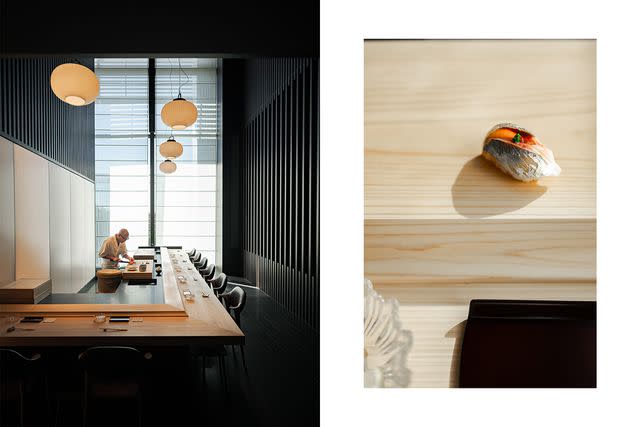
Irwin Wong
From left: The Sushi Hōseki restaurant at the Bulgari Hotel; aji, or horse mackerel, at the restaurant.Tomoyuki Sugano pitched for the Giants. Isaac had always wanted to see him play, so he was ecstatic. He explained that Sugano had the opportunity to play in the MLB, but ultimately chose to stay in Japan. For Waz, this seemed to be a point of pride. Sugano lived up to the hype, throwing seven shutout innings, absolutely dominating the BayStars. We — by now Isaac and I considered ourselves part of the collective “we” — beat them 6-0. Everyone screamed and swung Giants towels in the air, before picking up their own garbage on the way out of the stadium. (That’s Japan!) Exhilarated, exhausted, and hoarse, we made our way back to our hotel.
Now that we had seen some baseball, we were ready for culture. The next day we hired a guide named RamKy. RamKy was raised in Kerala, India, and is studying business at Hitotsubashi University. He offered us his “Signature Tokyo” tour, which in his words “presents Tokyo as a living, breathing city.” He delivered on what he promised.
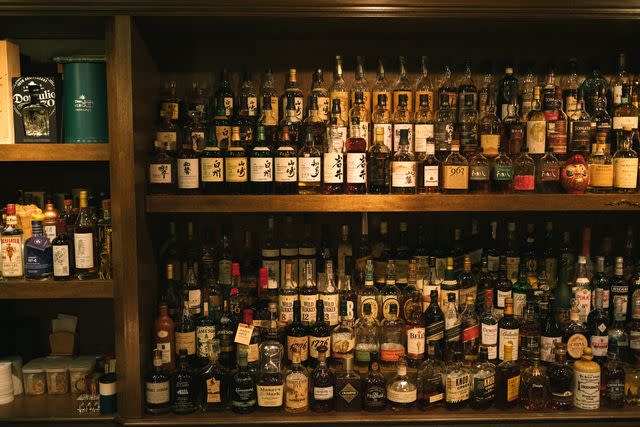
Irwin Wong
Bar High Five, in the Ginza.We visited Sensō-ji, in Asakusa. Completed in the year 645, it’s the oldest Buddhist temple complex in Tokyo, and the most famous. There are two gates leading to this colorful and head-spinningly beautiful place. The first, popularly known as the Kaminarimon, is flanked by statues of the old Shinto gods of wind and thunder. On the other side of the gate is Nakamise-dori, a street with about 90 stalls, some hawking rice crackers or grilled mochi on a stick, others selling toothbrushes and hairbrushes. We walked under three giant paper lanterns to the temple itself. According to RamKy, the third lantern was paid for by sex workers, for good fortune and to prevent STDs, in the 1600s. We rinsed our hands and mouths with water from a fountain and inhaled incense before bowing at the altar. After, we meandered by a koi pond, and an elderly Japanese gentleman explained to us that the fish are sometimes worth thousands of dollars. He also invited us home for tea. Via RamKy we politely demurred — there were so many more sights to see!
Related: 3 Itineraries for Travelers Finally Heading Back to Japan
In a quest for more beauty, we visited the Nezu Museum, in the Aoyama neighborhood, which featured an exquisite exhibition of painted screens in a building by the contemporary architect Kengo Kuma. Isaac and I both enjoyed the narrative paintings, which reminded us of graphic novels. Still, this was definitely “mom time.” The nearby Meiji Jingu Shinto shrine was another urban oasis surrounded by 173 acres of woods right in the middle of the city. Talk about forest bathing! It soothed my soul when I got cranky in the heat, which was beastly.
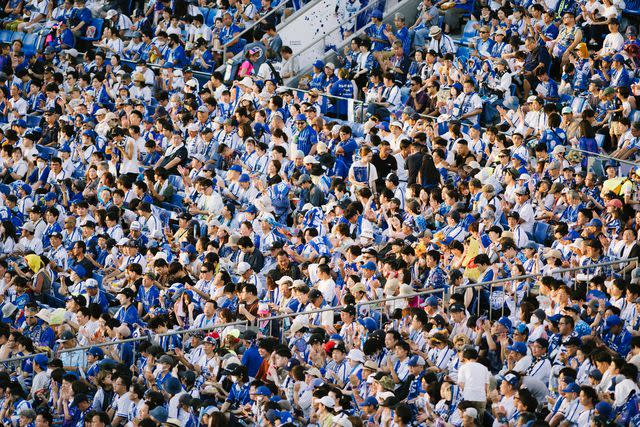
Irwin Wong
BayStar fans at Yokohama Stadium.At the opposite end of the cultural scale, on another day we took a walking tour of Harajuku, a neighborhood that is ground zero for kawaii (“cute”) culture — cute fashion, cute toys, and, yes, even cute food. We saw young women dressed up as “Lolitas,” in flouncy skirts, petticoats, lace, ribbons, and parasols. “Decora” style was startling and fun — playful and childlike, with its adherents dressing up like toys and dolls, with wigs and hair extensions, silly hats, sparkly makeup, and colorful spangled accessories like leg warmers, tutus, knee socks, even decorative Band-Aids. A lot of the young men emulated boy-band stars, with long hair often dyed gray, blue, or purple. We stopped in stores selling cute candies, cute stickers, and cute outfits, eating as we went — sweet potato treats, roll-your-own maki, frozen mochi with perfect strawberries hidden inside that we cut open with a little accompanying string.
"We were presented with three different cuts of tuna — first the “marble” variety, which Chef Shimizu told us was from the neck of the fish. I thought it was the best thing I had ever eaten, but we had only just begun."
Isaac and I both love new dining experiences, which in Tokyo more than sustained our athletic and cultural adventures. Our big splurge was an omakase dinner at the eight-seat Sushi Hōseki restaurant at the Bulgari Hotel Tokyo, opened under the direction of chef Kenji Gyoten. Omakase means “I’ll entrust it to you” — in other words, chef’s choice, which allows Gyoten to make use of whatever is freshest and most appealing each day. Everything at this small, spare space reflects his aesthetic: minimalist with clean, modern lines and a single table made of a 180-year-old piece of blond hinoki wood. A private seating had been arranged for the two of us, and Isaac and I were intimidated at first: We didn’t quite know how to behave. Fingerbowls or hand towels? Chopsticks or fingers? But when the talented chef de cuisine, Takuro Shimizu, bowed to us, we bowed back.
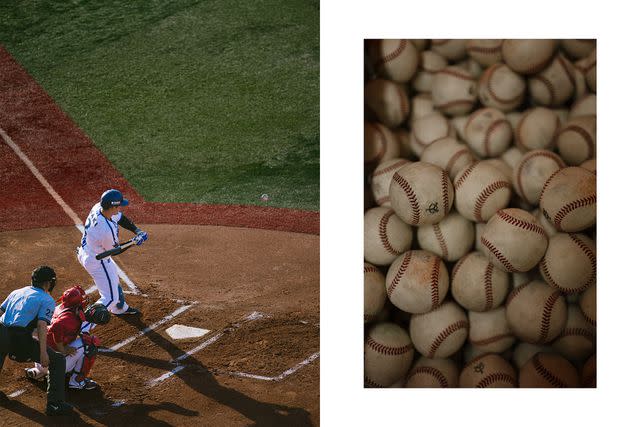
Irwin Wong
From left: Shugo Maki of Japan's Yokohama DeNA BayStars at bat in his home stadium; balls printed with the the Yomiuri Giants' logo.Saki Matsumoto was our server and interpreter. It was also her job to keep the marvelous drinks flowing, and she immediately poured us Hakkaisan sparkling sake in cups we selected from an elegant tray. We were presented with three different cuts of tuna — first the “marble” variety, which Chef Shimizu told us was from the neck of the fish. I thought it was the best thing I had ever eaten, but we had only just begun. The next two pieces were from the tuna’s back and belly, and tasted like they were from different species. We had nishin — herring cut to look like a silvery piece of Art Deco jewelry. Even the squid melted in our mouths. When we finally left, we were reduced to silence by the pleasure and purity of the experience.
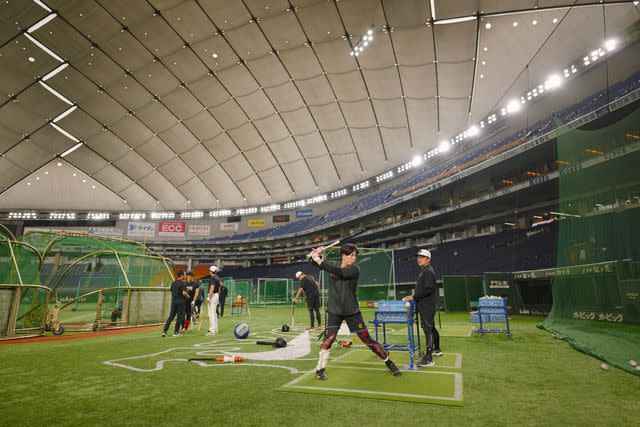
Irwin Wong
The Yomiuri Giants at batting practice.Another evening we ate at Harukor, a tiny, five-table Ainu restaurant, the only one of its kind in Tokyo. The Ainu are the Indigenous people of northern Japan. They were colonized and forced off their land by the Japanese, made to give up their lifestyle as hunter-gatherers and forbidden from speaking their language and practicing their religion. In recent years, as with many Indigenous peoples around the world, the Ainu have begun to reclaim their rights, language, and culture. The owner, a warm woman named Teruyo Usa, along with her husband, cooks a fusion of Japanese and Ainu cuisine. On the night we visited, the atmosphere was cozy. The walls were covered with Ainu art, and Ainu music was on the stereo. The couple’s young daughter did her homework near the counter while Isaac and I sampled wild leeks prepared three different ways, mashed pumpkin, and a delectable roast mackerel.
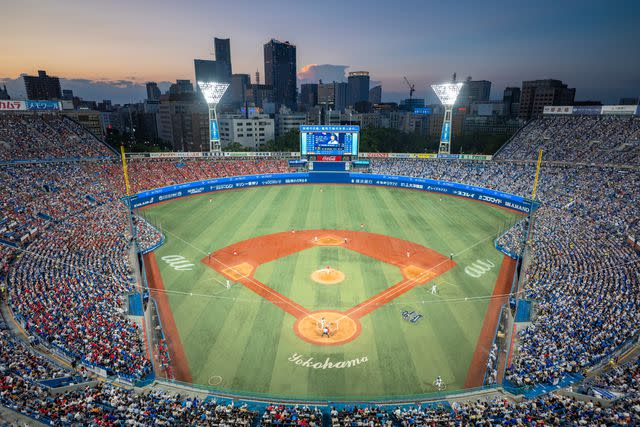
Irwin Wong
Yokohama Stadium.Another memorable evening came thanks to the hotel OMO5 Tokyo Otsuka, part of the Japanese group Hoshino Resorts. Otsuka is a small neighborhood with quiet streets, a tram service, and, for Tokyo, a remarkable lack of cars; it is also home to a large population of Vietnamese, Indian, and Bangladeshi immigrants looking for an affordable place to live that is an easy commute to the city center.
Related: How a 2-Week Trip to Tokyo Changed My Mind About Solo Travel
Two guides from the hotel took us to a nearby izayaka called Otsuka Torichu. Misako Murata, the boisterous wife of the manager, didn’t speak any English, but soon she and Isaac were somehow talking baseball — she had seen his Yakult Swallows cap, and was a Giants fan. Japanese whisky and beer were poured, and grilled asparagus, mushroom caps, and onions were served as we sat cross-legged on tatami mats, our guides from the hotel laughing, conducting the conversation and the ordering. When we left, our host gave Isaac a Yomiuri Giants bag to take home with him.
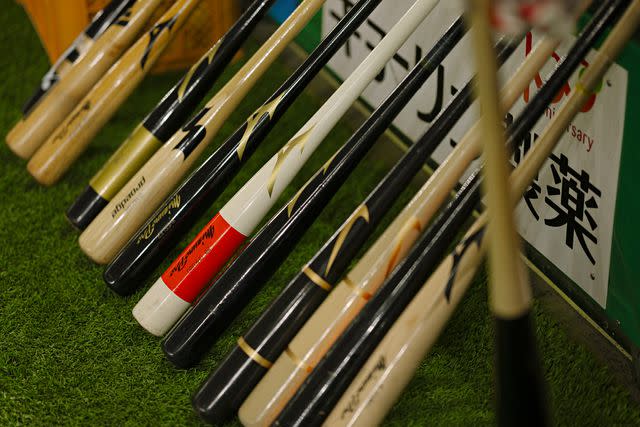
Irwin Wong
Bats lined up for practice at the Tokyo Dome.Which brings us back to baseball. On our last day we took a 90-minute train trip from OMO5 to Yokohama Stadium to see the DeNA BayStars play a home game, this time against the Hiroshima Toyo Carp. We were greeted by our official BayStars tour guides, Shinya Aoki and Reika Ushara. They had brought along an English-speaking, baseball-loving friend for Isaac, a young man named Joshua Bosley who was born in California and reared in Japan. This time we were less jet-lagged and more at ease. The stadium was beautiful and open to the sky, and the seats were painted in waves of different shades of blue. Empty, they reminded us of the eponymous bay, which was close by. This time we got a chance to chat with some of the players, with Josh serving as our interpreter. We talked with Shugo Maki, the BayStars’ best hitter, and Shōta Imanaga, a pitcher who starred in last year’s World Baseball Classic, which Japan won. Both players spoke about the pride they felt representing their country and bringing the title home.
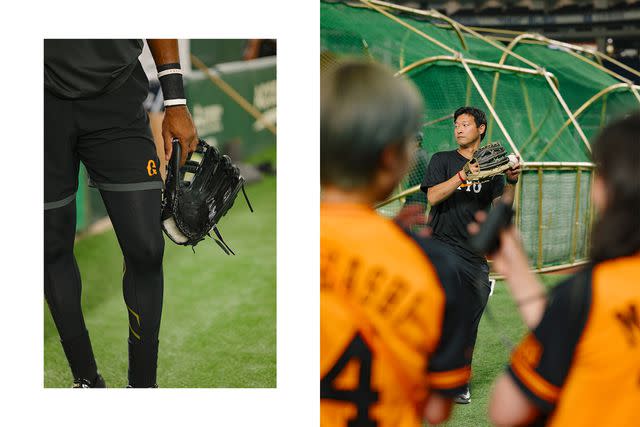
Irwin Wong
From left: Giants outfielder Lewis Brinson at batting practice; fans watch the Giants practice.Once the game started, the audience revved up. Female cheerleaders ran around the stadium. The uriko, or female beer sellers, flew up and down the stadium steps in fluorescent shorts and miniskirts, with kegs full of beer in their backpacks and spray guns to fill up fans’ plastic glasses. I don’t know how they stayed so animated and cheerful. The fans chanted and sang, waved towels in the air, and clacked together plastic bats to show their devotion.
The game came down to a final out. Our new friend Shugo Maki hit a long foul ball that just missed being a home run, before striking out to end the game. I expected tears and curses, but instead the night took an unexpectedly magical turn. It was one of three Blue Light Series concerts at Yokohama Stadium, an after-the-game musical festivity. The lights went out, and we all turned on the blue-light flash pens we had been given when we entered the stadium. A reggae band, Shōnan no Kaze, sauntered out onto a hastily made stage and sang three songs accompanied by fireworks, a light show, and a flame and smoke machine. The concert was projected on the scoreboard, with some of the lyrics written in English. Everyone sang along, even us. Their finale was a song called “Suirenka.”
“Let’s enjoy yourself!” we sang. “Let’s enjoy yourself! Wo, wo, wo!”
And we did.
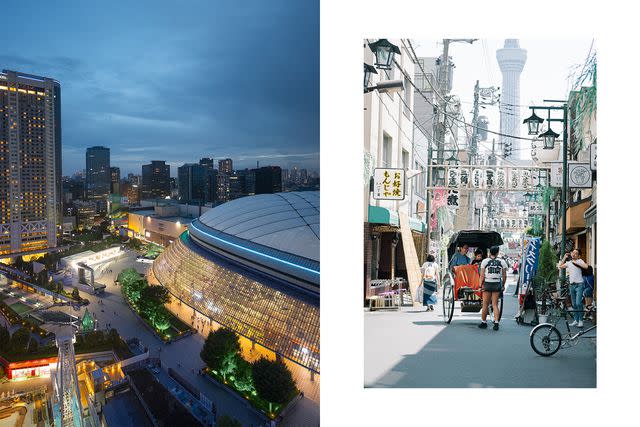
Irwin Wong
From left: The Tokyo Dome at nightfall; a street in Tokyo's Asakusa district.Where to Stay
Four Seasons Hotel Tokyo at Otemachi
This quietly luxurious property in a financial district high-rise has 190 rooms and suites with expansive views of the city. For baseball fans, the hotel is within walking distance of the Tokyo Dome.
OMO5 Tokyo Otsuka by Hoshino Resorts
OMO5 provides a warm, authentic experience in a quiet neighborhood. A team of “OMO Rangers” offers cultural and culinary tours of the area. A bonus: you can do your own laundry.
The Peninsula Tokyo
The Peninsula Tokyo is an urban oasis in a 24-floor tower overlooking the Imperial Gardens. The sole Japanese outpost of the opulent chain has what might be the world’s most gorgeous pool.
Trunk (Hotel) Cat Street
It’s hard not to have fun at this stylish property, with its location in the lively Shibuya district, a young and cool staff, and a commitment to sustainability.
Where to Eat and Drink
Bar High Five
A small, dark underground bar in the Ginza, this is the kind of place where you’ll end up having a friendly conversation with the bartender, who’ll invent something special just for you.
Est
Chef Guillaume Bracaval’s Michelin-starred Japanese-French restaurant at the Four Seasons Otemachi has a sublime 10-course tasting menu that highlights locally sourced ingredients.
Harukor
This tiny restaurant celebrates and preserves the cuisine of the Indigenous Ainu people, with a spotlight on fish, game, and foraged herbs and vegetables.
Onigiri Bongo
The specialty at Onigiri Bongo is rice balls wrapped in seaweed. Isaac’s were stuffed with jellyfish and plum, mine with mustard greens and salmon flakes. Well worth the long wait to get in.
Sushi Hōseki
The name of this eight-seat omakase in the Bulgari Hotel means “gemstone.”
Tsukiji Outer Market
Go to the fish market and roam the stalls in search of super-fresh sushi, rice bowls, and fish — all at bargain prices.
What to Do
Mitsukoshi Ginza
This is a high-end department store with an amazing food hall. Look for tea, rice, incredible pastries, and square watermelons.
Nezu Museum & Gardens
A breathtaking private collection of paintings, sculpture, ceramics, textiles, and armor, housed in an elegant contemporary building designed by Kengo Kuma. Don’t miss the lovely gardens.
TeamLab Planets Tokyo
Our favorite outing was this magical museum with immersive installations, such as a wading pool with projections of giant carp that explode into flowers and a living garden of hanging orchids you can lounge beneath.
Tokyo Metropolitan Teien Art Museum
Built in 1933 as the magnificent Art Deco home of a member of the royal family, this one-of-a-kind museum hosts rotating exhibitions.
How to Book
Arigato Japan Crazy Cute Kawaii Food Tour
Explore Harajuku and Omotesando, the colorful and chaotic home of cute culture and food, with stops for a traditional sweets tasting and an okonomiyaki lunch.
RamKy
Ramesh Krishnan is smart, knowledgeable, and highly entertaining — a fantastic and fascinating guide.
For more Travel & Leisure news, make sure to sign up for our newsletter!
Read the original article on Travel & Leisure.

